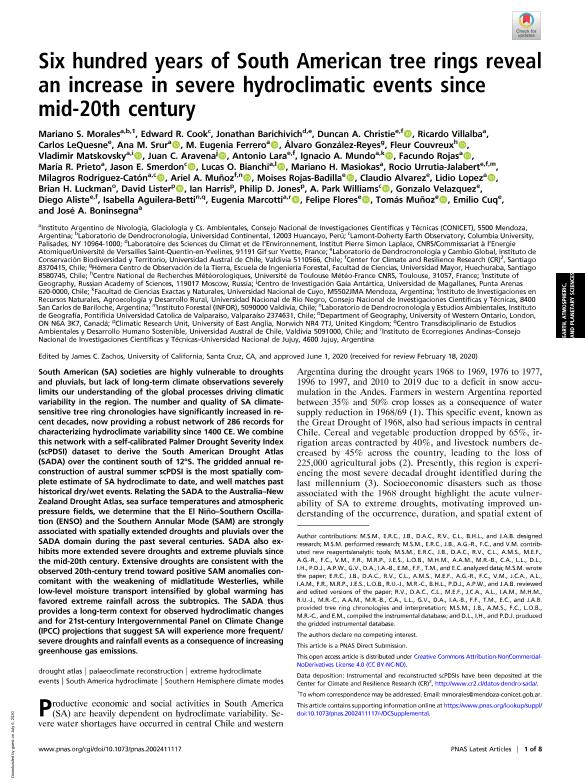Artículo
Six hundred years of South American tree rings reveal an increase in severe hydroclimatic events since mid-20th century
Morales, Mariano Santos ; Cook, Edward; Barichivich, Jonathan; Christie, Duncan A.; Villalba, Ricardo
; Cook, Edward; Barichivich, Jonathan; Christie, Duncan A.; Villalba, Ricardo ; LeQuesne, Carlos; Srur, Ana Marina
; LeQuesne, Carlos; Srur, Ana Marina ; Ferrero, Maria Eugenia
; Ferrero, Maria Eugenia ; González Reyes, Álvaro; Couvreux, Fleur; Matskovsky, Vladimir
; González Reyes, Álvaro; Couvreux, Fleur; Matskovsky, Vladimir ; Aravena, Juan C.; Lara, Antonio; Mundo, Ignacio Alberto
; Aravena, Juan C.; Lara, Antonio; Mundo, Ignacio Alberto ; Rojas, Juan Facundo
; Rojas, Juan Facundo ; Prieto, María R.; Smerdon, Jason E.; Bianchi, Lucas Osvaldo
; Prieto, María R.; Smerdon, Jason E.; Bianchi, Lucas Osvaldo ; Masiokas, Mariano Hugo
; Masiokas, Mariano Hugo ; Urrutia Jalabert, Rocio; Rodriguez Catón, Milagros Rocío
; Urrutia Jalabert, Rocio; Rodriguez Catón, Milagros Rocío ; Muñoz, Ariel A.; Rojas Badilla, Moisés; Alvarez, Claudio; Lopez Callejas, Lidio
; Muñoz, Ariel A.; Rojas Badilla, Moisés; Alvarez, Claudio; Lopez Callejas, Lidio ; Luckman, Brian H.; Lister, David; Harris, Ian; Jones, Philip D.; Williams, A. Park; Velazquez, Gonzalo; Aliste, Diego; Aguilera Betti, Isabella; Marcotti, Eugenia
; Luckman, Brian H.; Lister, David; Harris, Ian; Jones, Philip D.; Williams, A. Park; Velazquez, Gonzalo; Aliste, Diego; Aguilera Betti, Isabella; Marcotti, Eugenia ; Flores, Felipe; Muñoz, Tomás; Cuq, Emilio; Boninsegna, Jose Armando
; Flores, Felipe; Muñoz, Tomás; Cuq, Emilio; Boninsegna, Jose Armando
 ; Cook, Edward; Barichivich, Jonathan; Christie, Duncan A.; Villalba, Ricardo
; Cook, Edward; Barichivich, Jonathan; Christie, Duncan A.; Villalba, Ricardo ; LeQuesne, Carlos; Srur, Ana Marina
; LeQuesne, Carlos; Srur, Ana Marina ; Ferrero, Maria Eugenia
; Ferrero, Maria Eugenia ; González Reyes, Álvaro; Couvreux, Fleur; Matskovsky, Vladimir
; González Reyes, Álvaro; Couvreux, Fleur; Matskovsky, Vladimir ; Aravena, Juan C.; Lara, Antonio; Mundo, Ignacio Alberto
; Aravena, Juan C.; Lara, Antonio; Mundo, Ignacio Alberto ; Rojas, Juan Facundo
; Rojas, Juan Facundo ; Prieto, María R.; Smerdon, Jason E.; Bianchi, Lucas Osvaldo
; Prieto, María R.; Smerdon, Jason E.; Bianchi, Lucas Osvaldo ; Masiokas, Mariano Hugo
; Masiokas, Mariano Hugo ; Urrutia Jalabert, Rocio; Rodriguez Catón, Milagros Rocío
; Urrutia Jalabert, Rocio; Rodriguez Catón, Milagros Rocío ; Muñoz, Ariel A.; Rojas Badilla, Moisés; Alvarez, Claudio; Lopez Callejas, Lidio
; Muñoz, Ariel A.; Rojas Badilla, Moisés; Alvarez, Claudio; Lopez Callejas, Lidio ; Luckman, Brian H.; Lister, David; Harris, Ian; Jones, Philip D.; Williams, A. Park; Velazquez, Gonzalo; Aliste, Diego; Aguilera Betti, Isabella; Marcotti, Eugenia
; Luckman, Brian H.; Lister, David; Harris, Ian; Jones, Philip D.; Williams, A. Park; Velazquez, Gonzalo; Aliste, Diego; Aguilera Betti, Isabella; Marcotti, Eugenia ; Flores, Felipe; Muñoz, Tomás; Cuq, Emilio; Boninsegna, Jose Armando
; Flores, Felipe; Muñoz, Tomás; Cuq, Emilio; Boninsegna, Jose Armando
Fecha de publicación:
07/2020
Editorial:
National Academy of Sciences
Revista:
Proceedings of the National Academy of Sciences of The United States of America
ISSN:
0027-8424
Idioma:
Inglés
Tipo de recurso:
Artículo publicado
Clasificación temática:
Resumen
South American (SA) societies are highly vulnerable to droughts and pluvials, but lack of long-term climate observations severely limits our understanding of the global processes driving climatic variability in the region. The number and quality of SA climatesensitive tree ring chronologies have significantly increased in recent decades, now providing a robust network of 286 records for characterizing hydroclimate variability since 1400 CE. We combine this network with a self-calibrated Palmer Drought Severity Index (scPDSI) dataset to derive the South American Drought Atlas (SADA) over the continent south of 12°S. The gridded annual reconstruction of austral summer scPDSI is the most spatially complete estimate of SA hydroclimate to date, and well matches past historical dry/wet events. Relating the SADA to the Australia–New Zealand Drought Atlas, sea surface temperatures and atmospheric pressure fields, we determine that the El Niño–Southern Oscillation (ENSO) and the Southern Annular Mode (SAM) are strongly associated with spatially extended droughts and pluvials over the SADA domain during the past several centuries. SADA also exhibits more extended severe droughts and extreme pluvials since the mid-20th century. Extensive droughts are consistent with the observed 20th-century trend toward positive SAM anomalies concomitant with the weakening of midlatitude Westerlies, while low-level moisture transport intensified by global warming has favored extreme rainfall across the subtropics. The SADA thus provides a long-term context for observed hydroclimatic changes and for 21st-century Intergovernmental Panel on Climate Change (IPCC) projections that suggest SA will experience more frequent/ severe droughts and rainfall events as a consequence of increasing greenhouse gas emissions.
Archivos asociados
Licencia
Identificadores
Colecciones
Articulos(IANIGLA)
Articulos de INST. ARG. DE NIVOLOGIA, GLACIOLOGIA Y CS. AMBIENT
Articulos de INST. ARG. DE NIVOLOGIA, GLACIOLOGIA Y CS. AMBIENT
Articulos(INECOA)
Articulos de INSTITUTO DE ECORREGIONES ANDINAS
Articulos de INSTITUTO DE ECORREGIONES ANDINAS
Citación
Morales, Mariano Santos; Cook, Edward; Barichivich, Jonathan; Christie, Duncan A.; Villalba, Ricardo; et al.; Six hundred years of South American tree rings reveal an increase in severe hydroclimatic events since mid-20th century; National Academy of Sciences; Proceedings of the National Academy of Sciences of The United States of America; 117; 29; 7-2020; 16816-16823
Compartir
Altmétricas



